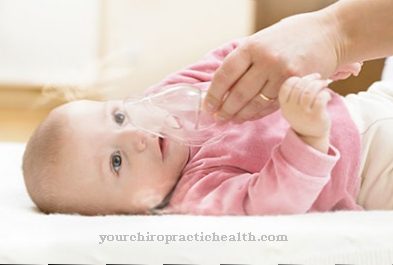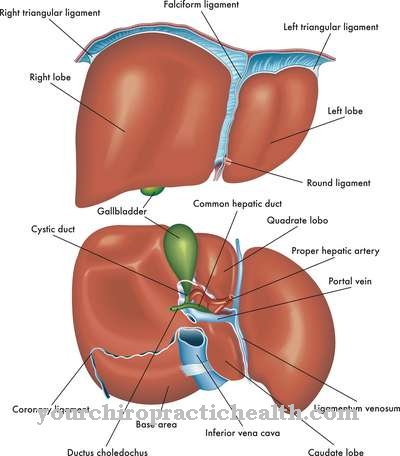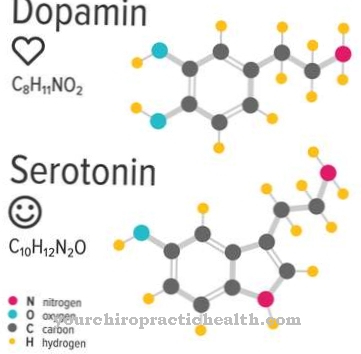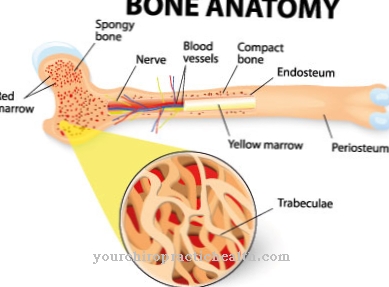A Cardiac arrest respectively Cardiovascular failure can have different causes. Rapid intervention is crucial for a good prognosis in the event of cardiac arrest.
What is cardiac arrest?
.jpg)
© Robert Kneschke - stock.adobe.com
In medicine, the failure of the cardiovascular system in an affected person is called Cardiac arrest designated. If such a cardiovascular failure occurs, it is often defined as clinical death.
Cardiac arrest can take several forms. For example, a so-called ventricular fibrillation can be present in the event of a cardiac arrest; the different heart muscle cells do not work in a coordinated manner, so that the heart cannot contract.
Cardiovascular failure is also possible in the form that the heart beats too fast to be able to fill sufficiently with blood between heartbeats. In addition, a cardiac arrest can be characterized by the fact that electrical nerve impulses can be measured in the heart, but these cannot lead to the heart working.
Signs that can almost certainly indicate cardiac arrest are, for example, a respiratory arrest, gasping for breath or a missing pulse from the main arteries.
causes
The most common cause of one Cardiac arrest is sudden cardiac death in people in industrialized nations. Such sudden cardiac death as the reason for cardiovascular failure can occur, for example, as a result of a heart attack.
In rarer cases, cardiac arrest can also be caused by so-called non-cardiac causes (i.e. causes that are not related to the heart): Such causes of cardiovascular failure include, for example, respiratory arrest or pulmonary edema (i.e. originating from the respiratory tract Causes).
Various impairments affecting the brain can also lead to cardiac arrest; For example, a stroke or traumatic brain injury can result in cardiac arrest. Last but not least, other incidents can lead to cardiovascular failure; such as electrical accidents or shocks suffered.
Symptoms, ailments & signs
Cardiac arrest is indicated by paleness, cold sweat and drowsiness. Shortly before cardiac arrest, those affected are often nervous and anxious. If there is a heart attack or cardiac arrhythmia, the typical symptoms of the respective cause appear. This can lead to heart pounding, tightness in the chest, dizziness, neck stiffness and a multitude of other signs, which on their own do not necessarily indicate an impending cardiovascular arrest, but in combination are a clear warning sign.
The actual collapse manifests itself in the fact that the person concerned becomes unconscious and can no longer be addressed. Typically, no breathing sound can be heard at the mouth or nose. At the same time, blood pressure drops and the heart stops beating. At this stage, a zero line can already be determined in the ECG.
The patient is in acute danger of death and there is a risk of brain death. With early treatment with a heart muscle massage, a pulse can be restored in the best case. However, cardiac arrest has severe after-effects such as confusion, physical and mental fatigue, and panic attacks. It is not uncommon for another cardiac arrest to occur after one has been overcome, usually with stronger symptoms.
Diagnosis & course
A Cardiac arrest Be diagnosed if a person has symptoms such as respiratory failure or a lack of pulse that affects the large arteries. Symptoms that may indicate cardiac arrest, but may also be the result of other diseases, include unconsciousness, convulsions or dilated, light-rigid pupils.
The course of cardiovascular failure in an individual case depends to a large extent on how quickly appropriate measures are taken. In principle, cardiovascular failure is reversible; this means that a victim can be reanimated. Whether such a resuscitation is successful and what consequential damage (such as brain damage due to a lack of oxygen) can occur, can depend in particular on immediate measures such as ventilation or chest compressions by laypeople until an emergency doctor arrives.
If medical intervention is not carried out in good time, cardiovascular failure can be fatal.
Complications
Various complications can arise as a result of cardiac arrest. In the acute phase there is initially hyperventilation and as a result often heart problems, cramps and swallowing of air. The tongue is rarely swallowed by the gasp, but this can lead to suffocation. Cardiac arrest can also lead to falls and accidents.
This can lead to fractures, bruises or very serious injuries, which are usually associated with further complications. If treatment is given too late in the case of cardiovascular failure, the insufficient oxygen supply can cause irreversible organ damage. The first thing affected is the brain, which is severely damaged after just a few minutes without oxygen supply and ultimately suffers brain death.
If treated incorrectly or too late, cardiac arrest can lead to death. In addition, drugs used with adrenaline, lidocaine or amiodarone can cause side effects and interactions. In the long term, cardiac arrest often results in cardiac insufficiency. Affected people then have to wear a pacemaker and take drugs for life. In addition to the physical consequences, this can also lead to psychological complaints and a general decrease in quality of life.
When should you go to the doctor?
If a person passes out, an ambulance must be called. A sudden drop in blood pressure and sweating can be the first signs of an impending cardiac arrest. If you notice these symptoms, you should not wait any longer to see a doctor. Cramps or dilated pupils also require examination and treatment. This must be clarified at the latest when gasping, neurological disorders or cardiac arrhythmias are noticed. People who have already suffered cardiovascular failure or respiratory arrest belong to the risk groups.
Likewise, people with a history of pulmonary edema or another disease that could cause cardiac arrest. If the cardiovascular failure occurs in connection with a stroke or a traumatic brain injury, emergency services must also be called in. Further therapy takes place in a general clinic or in a specialist center for cardiovascular diseases. Possible contacts are the family doctor, a cardiologist or an internist. Children and adolescents should be brought to the pediatrician when the symptoms mentioned occur, who can make a diagnosis and prepare for further therapy.
Treatment & Therapy
A Cardiac arrest is always considered a medical emergency. An important immediate measure in the event of cardiovascular failure is immediate cardiopulmonary resuscitation to save the life of a person affected. In the case of cardiac arrest, first aid measures such as chest compressions can be successful in the short term; In addition, rapid, further medical measures such as defibrillation or medication are often necessary.
Defibrillation describes a treatment method in which an affected person receives electric shocks in order to animate the heart. Defibrillation can be used, for example, in cardiovascular failure caused by ventricular fibrillation or ventricular flutter - in other words, in various forms of cardiovascular failure.
Medication may be necessary after cardiovascular failure, for example, if the cardiovascular failure is caused by an accelerated heartbeat, an impaired pacemaker or other reasons that do not come from the heart. In the latter cases, defibrillation is usually an ineffective measure for the medical treatment of cardiovascular failure.
Outlook & forecast
Cardiac arrest is a medical emergency. The person concerned is in acute danger of death and must be treated immediately by an emergency doctor. If the necessary resuscitation measures are initiated immediately, there is a relatively high chance of recovery. The chances of survival are also based on the cause of the cardiac arrest and the patient's constitution. According to the German Resuscitation Register, around 10 to 15 percent of those affected survive cardiac arrest. The association also states that immediate resuscitation measures can double or triple the patient's chances of survival. In the long term, around 75 percent of all survivors will be able to work again after cardiac arrest.
In the first few months, side effects such as exhaustion and circulatory problems occur, which can significantly reduce well-being and quality of life. Comprehensive medical supervision is necessary in any case. The prognosis can be improved by strictly adhering to the medical guidelines regarding diet, exercise and the like. Then a full recovery may even be possible. The prognosis after a cardiac arrest depends on various factors, but in principle it is relatively good if the person concerned survives the actual cardiac arrest.
prevention
To one Cardiac arrest As a rule, the most important thing to prevent is to prevent the various possible causes of cardiac arrest. For example, cardiac arrhythmias, heart attacks and strokes are the main causes of cardiac arrest, favored by obesity and high blood pressure. The latter factors can be prevented, for example, through regular exercise, balanced eating and a conscious use of nicotine and alcohol.
Aftercare
In the event of cardiac arrest, there are usually no special follow-up options available to those affected. In most cases, cardiac arrest also leads to death if it is not recognized in time. Therefore, a doctor should be consulted at the first signs or symptoms of this complaint so that this complication does not occur.
An emergency doctor should be called immediately or a hospital should be visited directly so that the person concerned can receive emergency care. Further follow-up measures are usually not available to the patient. Since cardiac arrest leads to the death of the patient in many cases, parents, families or other relatives are dependent on psychological support and advice.
Loving conversations and intensive support for those affected have a very positive effect on the further course of these complaints. Depression or other psychological upsets can also be prevented. If cardiac arrest is treated, the affected person should take care of their heart after the treatment and not expose themselves to stressful or physical activities, as these would put unnecessary strain on the heart.
You can do that yourself
Cardiac arrest is a life-threatening situation where every second counts. The relatives or first aiders should first alert the emergency doctor immediately. Until medical help arrives, first aid measures must be provided. Very important: do not lie down the person affected, but rather lay the upper body upwards so that the heart is relieved. In addition, tight clothing should be loosened so that the sick can get air. The resuscitation measures must then be started immediately. If available, a defibrillator can be used. Otherwise, chest compressions or mouth-mouth / nose resuscitation should be performed.
If the person concerned is conscious, it is important to calm them down and avoid stress and excitement until the emergency doctor arrives. The sick person will then have to spend a few days in the hospital. Rest and bed rest are primarily indicated.
As soon as the cause of the cardiac arrest is known, therapeutic measures can be started. In general, light exercise such as physiotherapy or yoga, dietary measures and avoiding stress are recommended. In short: a healthy and conscious lifestyle. Additional support from relatives can help to consistently pursue the new lifestyle and avoid further cardiac arrest.



.jpg)




















.jpg)



